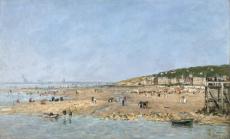


Eugène Boudin was born in Honfleur, a little Normandy harbour, to a seafaring family of modest means. Soon afterwards, his family moved to the nearby town of Le Havre. Boudin’s entire oeuvre as a painter would remain intimately linked to this region and his origins. At a very young age, he became an apprentice at a stationer’s that also supplied artists’ materials, before going on to open his own shop. It was through contact with his clientele – artists who came to paint in the area – that the young Boudin learnt the rudiments of his art.
Boudin’s debut at the Paris Salon in 1859, when he was already in his mid-30s, marked the true beginning of his career. On the occasion of the 1859 Salon, Charles Baudelaire sang the praises of the painter who showed him ‘several hundred pastel studies improvised before the sky and the sea’, by admiring the ‘clouds with their fantastic and luminous forms, this chaotic darkness, these green and pink immensities, suspended and added to each other, these gaping furnaces, these firmaments of black or violet satin, crumpled, hemmed or torn, these horizons in mourning or dripping with molten metal, all these profundities, all these splendours’. It seems the poet and critic understood very well the aspirations of the painter, who, on 3 December 1856, made the following note to himself: ‘[…] swim midair. Reach the tenderness of the cloud. Suspend these masses in the background, far away, amid the grey mists, make the blue explode.’ It was this interest in natural phenomena, which he never lost, that made him a precursor of the Impressionists.
Boudin developed a very personal art, in which the careful description of nature, rain, fair weather, and the magnificence of blue skies occupy a large part. The human figure also finds its place in this universe; it is a humanity which is very contemporary. Many paintings depict Breton peasants or seamen, observed during the painter’s frequent sojourns in Brittany, a province still unaffected by modernity and possessing a picturesque quality which painters had begun to exploit. However, it was very close to Le Havre that Boudin found his preferred subject, by portraying Parisian high society and the bourgeoisie enjoying bathing at the new seaside resorts established during the Second Empire – Deauville and Trouville. Thus, between 1863 and 1868, Boudin became the painter of high-society beaches, of women holding parasols and dressed in crinolines and hats with ribbons waving in the wind, walking or sitting on chairs in small animated groups, flanked by gentlemen wearing bowlers or top hats and accompanied, in the foreground, by restless little dogs. This benevolent and visually sparkling chronicle of contemporary life, which dares to ‘depict things and people of our time [and] to render acceptable the gentleman in his coat and the lady in her rain cape’, according to the painter’s own words, is of an originality and daring boldly claimed by the artist. Boudin expressed ‘the heroism of modern life’;and depicted the ephemeral quality of an era in fashions and manners, which is ordinarily neglected. He nevertheless refused to restrict himself to one successful formula and, great traveller that he was, went on to devote himself to the description of the shores and the harbours of the Atlantic and the Mediterranean, journeying as far as Venice.
Nevertheless, Boudin did not completely abandon Trouville and worked there regularly between 1875 and 1897. The painting in the A. G. Leventis Collection, precisely dated to 1889, was an opportunity for him to return to the beach at Trouville and to elaborate, by his own admission, a particularly ambitious tableau. The painter adopted a slightly elevated point of view by placing his easel on the pier above the estuary of the River Touques, which separates Trouville from Deauville. The elegant hotels and villas by the beach, like the holidaymakers with their parasols on the shore, conjured up by miniscule touches which are yet so expressive, are still present, as they are in the earlier paintings, but are now subject to the scale of the panorama of the coast and the immense sky, subordinated to the description of the site with its evocation, on the horizon, of the environs of the port of Le Havre, with its grey smoke. Reinvented, the painter’s vision lost nothing of its freshness and visual acuity; his touch, consistently light and animated from one end of the canvas to the other, confers its rhythm to the composition.
As an apprentice in a shop in Le Havre that supplied art materlias, he becamse acquainted with many well-known painters. Following his art studies in Paris (1851-1854), he returned to Le Havre; many of his workds are landscapes and marine scenes of this harbour town and its surroundings. He was one of the first artists to paint en plain air, and his works emphasise nature, weather conditions and blue skies. He created brightly lit chronicles of contemporary life, particularly at the seaside resorts of Deauville and Trouville. A young Claude Monet was encouraged by him to paint outdoors.